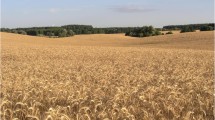Abstract
Tigray (region) is one of the major finger millet growing regions in Ethiopia and an important site from an archeobotanical point of view. Three zones of Tigray (east, central and west) were identified as representative sites in the region and a total of 14 districts/ ‘Woreda’ were surveyed. Thirty-seven landraces/farmers’ varieties of finger millet were identified/recorded. Farmers in Tigray undertake pre and post harvest selection in finger millet and sometimes they also select seeds from storage based on a number of attributes. Farmers maintain diversity as a way to ensure harvest security or stability of production, to promote diversity of diet and income sources, minimize crop failure risk, reduce insect and disease incidences and ensure efficient use of labour. The traditional management of finger millet in the entire study area is generally found to be demand driven, showing the existence of potential sites for on-farm conservation. The high morphological diversity (H =0.76 ± 0.09) found in the gene bank collections of Tigrayan origin also reveals the importance of linking ex situ with in situ conservation activities. Furthermore, the enhancement and conservation significance of the crop is discussed.
Similar content being viewed by others
References
Altieri M. and Merrick C.L. (1987). Econ. Bot. 41(1): 86–96
Asfaw Z. 1997. Ethnobiology in enhancement and utilization of landraces. In: Fassil K., Abebe D. and Seyfu K. (eds), Community Biodiversity Development and Conservation. Proceedings of the first meeting of the national project advisory and overseeing committee (NPAOC), coordinating unit and partner institutions. Addis Ababa, Ethiopia, pp. 62–71.
Bellon M.R. (1996). The dynamics of crop infraspecific diversity: a conceptual framework at the farmer level. Econ. Bot. 50(1): 26–39
Bellon M.R. (2003). Conceptualizing interventions to support on-farm genetic resource conservation. World Dev. 32: 159–172
Bellon M.R. and Taylor J.E. (1993). Farmer soil taxonomy and technology adoption. Econ. Dev. Cult. Change 41: 764–786
Berg T. (1993). The science of plant breeding-support or alternative to traditional practices?. In: De Boef, W., Amanor, K., Wellard, K. and Bebbington, A. (eds) Cultivating Knowledge: Genetic Diversity, Farmer Experimentation and Crop Research, pp 72–77. Intermediate Technology Publications Ltd., UK
Brush S.B. (1991). Farmer-based approach to conserving crop Germplasm. Econ. Bot. 45: 153–165
Bureau of Agricuture and Natural resources Development (BoANRD). (1997). Tigray soil and water conservation action programmedraft main report. Mekelle, Ethiopia
CSA. (1999). Agricultural sample survey. Report on area and production for major crops. Statistical Bulletin. Central Statistical Authority (CSA), Addis Ababa, Ethiopia
De Wet J.M.J., Rao K.E.P., Brink D.E. and Mengesha M.H. (1984). Systematics and evolution of Eleusine coracana (Gramineae). Amer. J. Bot 71(4): 550–557
FAO. (1996). Global plan of action on the conservation and sustainable utilization of plant genetic resources. FAO, Rome
Guarino L. (1995). Secondary sources on cultures and indigenous knowledge systems. In: Guarino, L., Rao, V.R. and Reid, R. (eds) Collecting Plant Genetic Diversity Technical Guidelines, pp 195–228. CAB International, Wallingford, UK
Hilu K.W., De Wet J.M.J. and Harlan J.R. (1979). Archaeobotanical studies of Elueusine coracana ssp. coracana (finger millet). Am. J. Bot. 66: 330–333
Jain S.K., Qualset C.O., Bhatt G.M. and Wu K.K. (1975). Geographical patterns of phenotypic diversity in a world collection of durum wheat. Crop Sci. 15: 700–704
Magurran A. (1991). Ecological Diversity and Its Measurements. Princeton University Press, Princeton
Mehra K.L. (1963). Considerations on the African origin of Eleusine coracana (L.). Gaertn. Curr. Sci 32: 300–301
National Research Council. (1996). Lost crops of Africa: Grains. 1. National Academy Press, Washington, D.C
Oosterhout V.S. (1993). Sorghum genetic resources of small-scale farmers in Zimbabwe. In: De Boef, W., Amanor, K., Wellard, K. and Bebbington, A. (eds) Cultivating Knowledge: Genetic Diversity, Farmer Experimentation and Crop Research, pp 89–95. Intermediate Technology Publications Ltd., UK
Phillips O. and Gentry A.H. (1993a). The useful plants of TambopataPeru: I. statistical hypotheses tests with a new quantitative technique. Econ. Bot. 47: 15–32
Phillipson D.W. 2001. Archaeology at AksumEthiopia. 1993-7. Vol I & II. David Brown book Co.
Ramachandra G., Virupaksha T.K. and Shadaksharaswamy M. (1977). Relationship between tannin levels and in vitro protein digestibility in finger millet (Eleusine caracana Gaertn.). J. Agric. Food Chem. 25: 1101–1104
SAS. (1999). SAS User’s guideReleased 8.2 editions. SAS Institute Inc., Cary, NC, USA
Teshome A., Torrance J.K., Baum B.R., Fahrig L., Lambert J.H. and Amase T.J. (1999). Traditional farmers’ knowledge of sorghum [sorghum bicolour [Poaceae] landrace storability in Ethiopia. Econ. Bot. 53: 69–78
Author information
Authors and Affiliations
Corresponding author
Rights and permissions
About this article
Cite this article
Tsehaye, Y., Berg, T., Tsegaye, B. et al. Farmers’ Management of Finger Millet (Eleusine coracana L.) diversity in Tigray, Ethiopia and Implications for on-Farm Conservation. Biodivers Conserv 15, 4289–4308 (2006). https://doi.org/10.1007/s10531-005-3581-3
Received:
Accepted:
Published:
Issue Date:
DOI: https://doi.org/10.1007/s10531-005-3581-3




